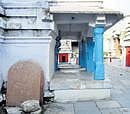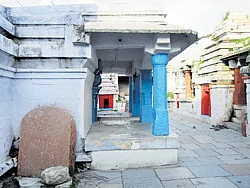

The village is on the left bank of the river Bhima and is about 40 km south-west of the taluk centre Chittapur on the Nalwar-Sannati road. You can get to Nalwar immediately after Wadi junction on the Mumbai-Chennai and Secunderabad-Chennai broad gauge. Called Koraluru in ancient inscriptions, the village is significant because it was a capital in the 11th-12th century. As many as five inscriptions dating back to 11th and 16th centuries have been discovered here. The Sali Basavanna temple and Rameshwara temple here are not often part of the tourist circuit, but are historically significant.
In fact, Chittapur taluk has the privilege of having the most number of Shiva temples out of the total 46 temples in Gulbarga district. The Someshwara temple referred to in the 12th century inscription is the present Basaveshwara temple in Kollur. It is one of the 12 temples existing in the names of Someshwara or Swayambhoosomeshwara in the district. Interestingly, there are 26 ancient Ramalinga or Ramalingeshwara temples in the district and Kollur is one of them. The Sali Basaveshwara temple is the oldest of the two. Oldest of the five inscriptions found in the village is in this temple. It is a chatushkuta temple with the navaranga having a garbhagriha (sanctum sanctorum) each with antarala in four directions. The east and west facing garbhagrihas have a sahasralinga each while the remaining garbhagrihas have shivalingas. The beautiful door frames of the garbhagriha are decorated with ornate panchashankhas and Gajalaxmi.
Hiriya Someshwara temple?
The artifacts are decorated with attractively carved makaratoranas (embellishments). The Nandimantapa corresponding to the garbhagriha on the south contains a beautifully carved Nandi in the lying position. The navaranga has heavy pillars with a variety of beautiful carvings. The temple with multiple angle plan has simple, unadorned walls. Historians say this is the Hiriya Someshwara Temple mentioned in the inscription of 1169 AD.
The Rameshwara temple, also known as Ramalingeshwara temple has three inscriptions. One of them has faded away and the other is still intact and legible. Braving vagaries of weather it may soon fade away if not protected. There is another small inscription in the wall at the entrance. The temple stands on the bank of river Bhima and the selection of the place of temple is so scientific that it has remained unbound to the flood fury caused often. From the temple one can enjoy the panoramic view of the river when it is in its elements in the thick of the monsoon.
The complex comprises 10 small temples and out of them the dwikuta Rameshwara is central to the complex. It has two garbhagrihas along with antaralas facing each other. The door frames are simple with trishankhas.
The navarangas have entrance from two flanks while the temple wall is unpretentious. It appears that these temples were erected in the names of members of the family of Mahamandaleshwara Allaullideva.
The carvings in both the temples have been coated in different colours of paints, and the beauty of the sculptures are lost. The twin temples, which should have been the pride of Kollur have become the favourite haunt of anti-social elements, who use them for activities such as gambling. It is a pity that the Archaeology Department has simply forgotten these temples.
